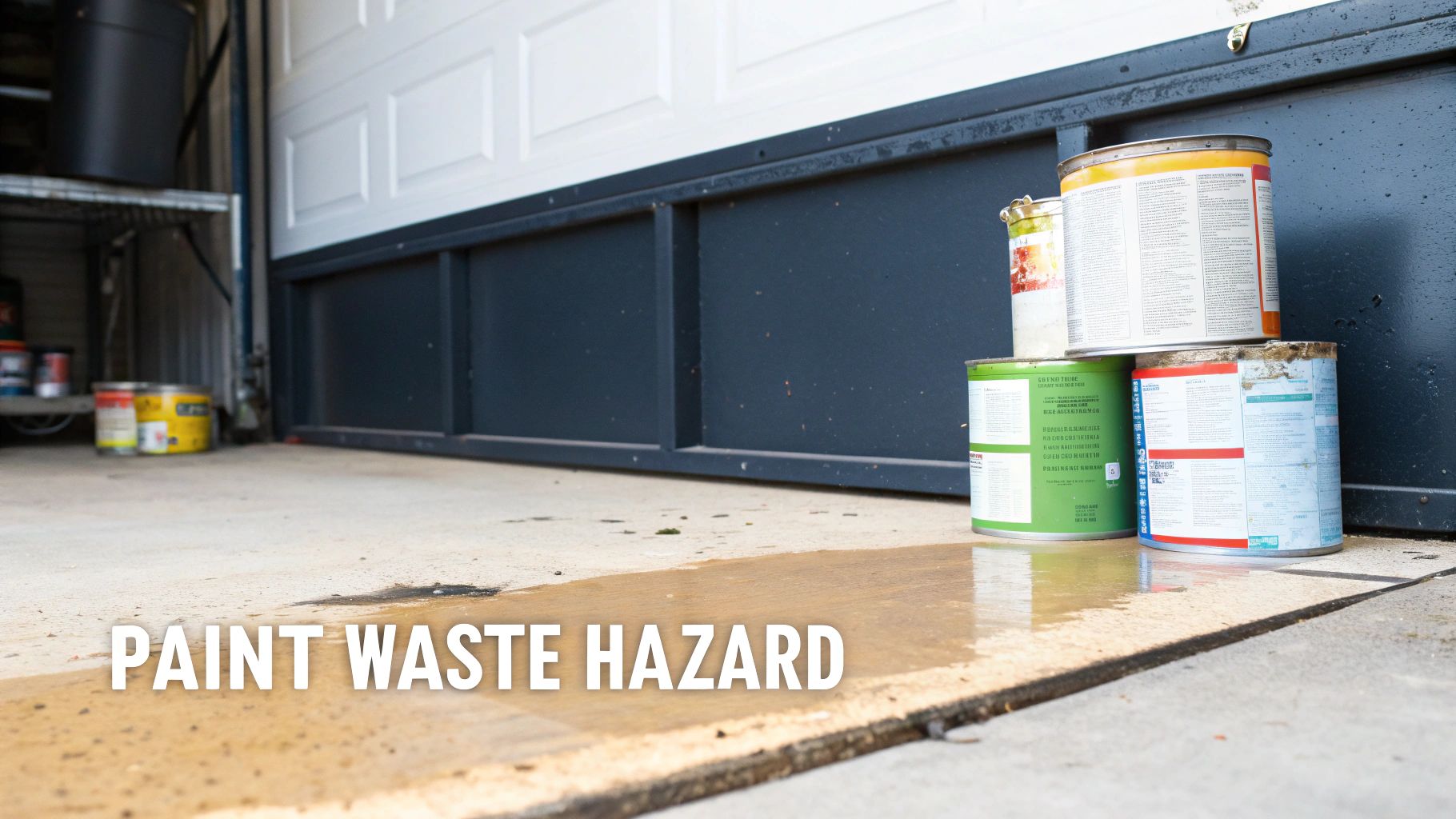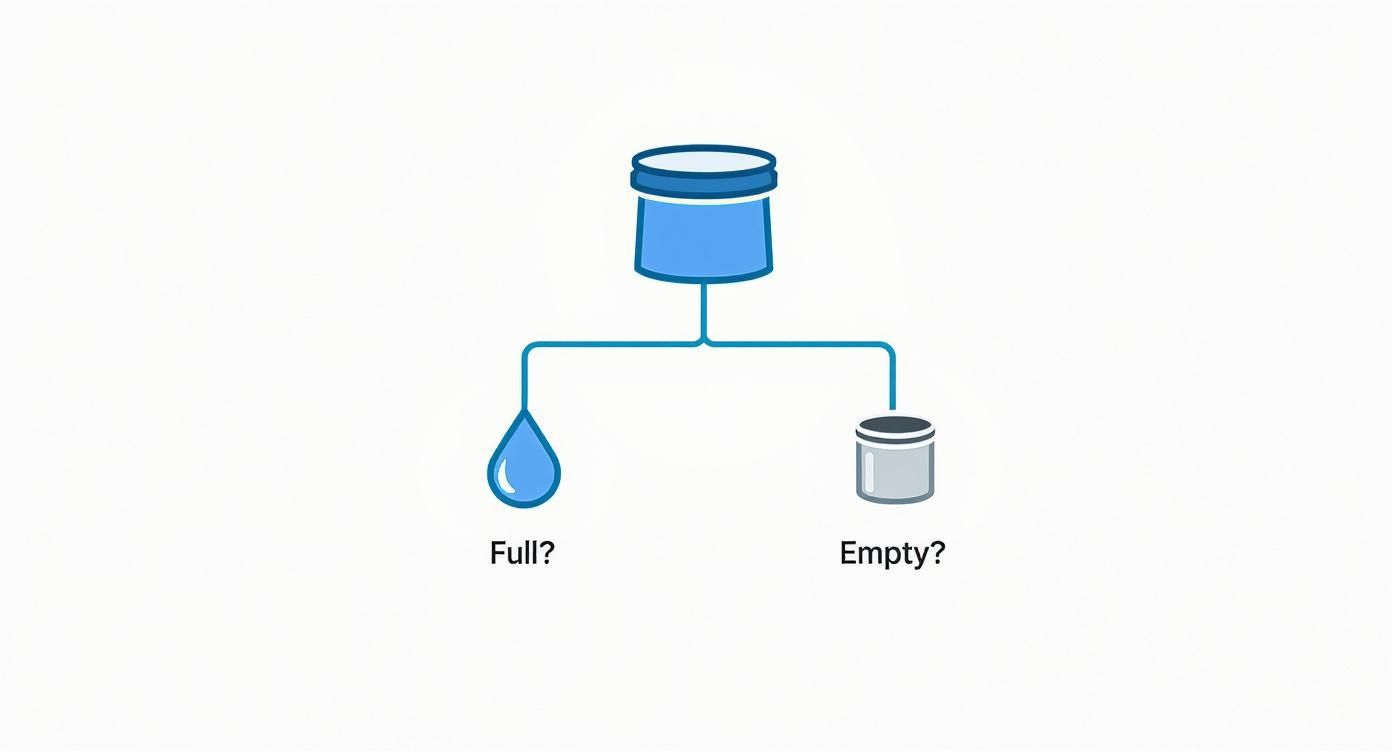How to Dispose Paint Tins The Right Way in the UK
How to Dispose Paint Tins The Right Way in the UK
Knowing how to dispose of paint tins the right way is pretty simple once you get the hang of it. For empty tins, it's usually a case of drying them out for recycling. For anything with liquid paint left, you'll need to take it to your local waste recycling centre. The one thing you must never do is pour liquid paint down the drain or chuck it in your regular bin – it's nasty stuff for the environment.
This guide will walk you through exactly what to do in every situation.
The Hidden Problem in Your Garage

Before we get into the practical steps, it helps to understand why this is such a big deal. Let's be honest, most of us are guilty of stashing half-used paint tins in the shed or garage, thinking we'll use them for touch-ups one day. But this collective habit has created a massive environmental headache.
Those old tins aren't just clutter; they're full of chemicals that can cause real harm if they get out.
The scale of this in the UK is genuinely staggering. It’s estimated that our homes are hoarding over 50 million litres of leftover paint. To give you some perspective, that's enough paint to coat the iconic Forth Rail Bridge 212 times. What's worse is that around 98% of this waste paint currently goes straight to landfill or incineration. You can dig into more of the data on this issue over at the Royal Society of Chemistry.
Why Improper Disposal Is a Major Concern
Just tossing a tin in the bin or washing the dregs down the sink has serious consequences. Most paints, particularly older solvent-based types, are packed with Volatile Organic Compounds (VOCs) and other chemicals.
When they end up in the wrong place, these substances can:
- Contaminate Soil and Waterways: Nasty chemicals can leach from landfill sites into the ground, polluting the groundwater that eventually feeds our rivers and streams.
- Harm Wildlife: Contaminants poison aquatic life and throw the entire ecosystem out of balance.
- Create Fire Hazards: Solvent-based paints and their thinners are extremely flammable, creating a serious fire risk in the back of bin lorries and at waste facilities.
The bottom line is that liquid paint is often classed as hazardous waste. That’s why councils and waste management services have strict rules for handling it. Learning how to dispose of your paint tins properly is a small action, but it's a genuinely impactful way to do your bit for the environment.
Getting Your Empty (and Almost Empty) Tins Ready
This is the classic post-decorating scene, isn't it? A line-up of paint tins, some totally empty, others with just a bit sloshing around in the bottom. Getting these ready for disposal is the most important step in making sure they get recycled instead of ending up in landfill. The golden rule is simple: no liquid paint.
For those tins with just a thin film of water-based emulsion clinging to the sides, the easiest trick is to just let them air dry. Pick a well-ventilated spot, safely out of reach of kids and pets, and just leave the lid off for a couple of days. That paint will harden up, making the tin perfectly fine to go in with your recycling.
What About the Thicker Gunk Left Over?
If you've got a bit more paint left – maybe up to an inch or so – leaving it to air dry isn't a great idea. It could take weeks and might attract unwanted garden visitors. The pro tip here is to add something absorbent to solidify what's left.
You’ve probably got what you need lying around the house or shed already:
- Sawdust
- A scoop of soil from the garden
- Shredded newspaper
- Cat litter (this works brilliantly)
Just tip your chosen material into the tin and give it a good stir. You’re aiming for a thick, clumpy, porridge-like consistency. Leave the lid off, and it should set solid in a day or two.
The ultimate test for kerbside recycling is straightforward: the tin must be bone dry with zero liquid. If you can turn it upside down and nothing comes out, you're good to go.
Before you chuck any paint tin in your recycling, it's always worth getting familiar with your local council's rules. A quick look at their website can save a lot of hassle. For instance, Birmingham City Council gives clear guidance on what they'll accept, which is typical for many areas.
We've put together a handy table to give you a quick overview of how to prep your tins.
Preparing Your Paint Tins for Disposal
| Tin Status | Water-Based Paint (Emulsion) | Oil-Based/Solvent-Based Paint (Gloss) | Acceptable for Kerbside Recycling? |
|---|---|---|---|
| Completely Empty & Dry | Clean and dry. | Must be completely empty with no residue. | Yes (Check local council rules first). |
| Small Residue | Leave lid off to air dry until solid. | Do Not Air Dry. Take to HWRC. | Yes, once fully solidified. |
| Larger Residue (Up to 1 inch) | Mix with sand, soil, or cat litter until solid. | Do Not Air Dry. Take to HWRC. | Yes, once fully solidified. |
| More Than 1 Inch Left | Treat as leftover paint, do not dry out. | Treat as leftover paint, take to HWRC. | No, this is too much to dry at home. |
This table should make it clear what to do, but the main takeaway is to always separate your oil-based paints.
Why Oil-Based Paints Are a Different Beast
It's absolutely vital to understand that oil-based or solvent-based paints (your glosses, varnishes, and satinwoods) are a completely different story. Their chemical makeup means they're classed as hazardous waste. You must not try to dry them out at home or put them in your household bins.
Even a tin that looks almost empty needs to be handled with care. These tins have to go to your local Household Waste Recycling Centre (HWRC) for safe disposal. The staff there are trained to deal with hazardous materials properly. Tossing one of these into your recycling can contaminate an entire lorry's worth of material, so keeping them separate is a big deal.
What to Do With Leftover Liquid Paint
When you're faced with a paint tin that's still got a good amount of liquid sloshing around inside, the game changes. Trying to dry it out just isn't practical or safe, especially when you're dealing with anything more than a tiny bit at the bottom. This is where community schemes and proper waste facilities become your go-to options.
This handy decision tree shows that first crucial step: figuring out if your tin is full or empty.

It’s a simple visual guide to point you in the right direction – either prepping the tin for recycling or finding a specialised disposal route for the liquid.
Give Your Paint a Second Life
Before you even think about disposal, stop and consider if someone else could use it. If the paint is still in good nick, it can be a fantastic resource for community groups, local theatre projects, or individuals who can't afford to buy new. The best way to do this is through the Community RePaint network.
This is a brilliant UK-wide scheme that collects leftover, reusable paint and gets it into the hands of people who need it. It’s a win-win: you clear out your garage, and good-quality paint gets used instead of being chucked away. You can find your nearest drop-off point right on their website.
The sheer scale of the UK’s leftover paint problem is shocking. Every year, around 34 million litres of decorative paint goes unused. The real kicker is that approximately 98% of this is disposed of unsustainably through landfill, incineration, or down the drain. You can learn more about how paint donation schemes are fighting this from leading waste management experts.
Your Local Recycling Centre Is the Final Stop
If your paint has seen better days—maybe it's gone lumpy, separated into a weird mess, or it’s a solvent-based type you can’t donate—then your local Household Waste Recycling Centre (HWRC) is the only correct final destination. Most HWRCs have a dedicated area for hazardous materials, and that includes liquid paint.
It's so important to get this right, and here’s why:
- Never Pour Paint Down the Drain. Liquid paint, especially oil-based gloss, is packed with chemicals and microplastics. These are toxic to aquatic life and can wreak havoc on water treatment systems. Pouring it away is illegal and incredibly damaging.
- Don't Just Chuck It in Your Bin. Liquid paint can leak from bin lorries, leaving a trail of pollution and mess on our roads. It’s also a fire hazard, particularly solvent-based paints.
When you get to the HWRC, just let the staff know you have liquid paint to dispose of. They'll point you to the correct spot, making sure it’s handled safely and professionally. Taking this little bit of extra time is a crucial step in protecting our local environment.
Metal Tins vs Plastic Tubs: What You Need to Know

When you're trying to figure out how to dispose of paint tins, the material of the container itself plays a massive role. Not all packaging is created equal in the eyes of a recycling facility, and knowing the difference can help you make a smarter choice before you even pick up a brush.
Metal paint tins, which are usually made of steel or aluminium, have a huge advantage in the UK's recycling world. Steel is brilliant because it's infinitely recyclable without losing any quality. Plus, its magnetic properties make it dead easy for recycling plants to pull it out from other waste streams. It’s a well-oiled, efficient system that just works.
The Problem with Plastic
Plastic paint tubs, on the other hand, face a much tougher journey. The biggest headache is contamination. Any leftover paint residue makes the plastic incredibly difficult to clean and process properly. Metal can be melted at scorching temperatures that simply burn off impurities, but plastic recycling needs much cleaner material to even stand a chance.
The difference in the numbers is pretty stark. Here in the UK, around 65% of metal paint cans are successfully recycled. But for plastic paint containers? That figure nosedives to just 9%. The efficiency of metal recycling is well-established, with steel packaging in general hitting recycling rates of up to 86.6%, according to sources like the Greenwashing Index.
Choosing paint in a metal tin over a plastic tub is one of the simplest, most effective ways to ensure the packaging has a good chance of being recycled after your project is complete.
This massive gap really shines a light on the ongoing plastic recycling challenges and opportunities we face in the waste industry. Because of the contamination and tricky sorting processes, many plastic tubs end up in landfill or incineration, even if you’ve put them in the recycling bin with the best intentions. By opting for metal, you’re actively choosing a more circular and sustainable packaging solution from the start.
Smart Ways to Reduce Paint Waste from the Start

The best way to deal with leftover paint is to avoid having any in the first place. It sounds obvious, I know, but a simple shift in mindset at the start of a project makes everything easier. It not only simplifies how to dispose of paint tins later on but also saves you money and stops your garage from turning into a paint graveyard.
One of the biggest mistakes people make is guessing how much paint they'll need for a job. Before you even head to the shop, get the tape measure out. Take proper measurements of the room and plug them into a free online paint calculator. These tools are surprisingly accurate, factoring in things like the number of coats and even the texture of the surface.
And please, resist the urge to buy that massive five-litre tin just because it looks like a bargain. Grab a few sample pots first to see how the colours actually look in your home's unique lighting. Committing to a colour before you buy in bulk means you won’t be stuck with a nearly full tin of a shade you can't stand.
Smart Storage for Longer Life
If you do have paint left over, storing it properly is the key to making sure it’s still good for future touch-ups.
When it's time to seal the tin, don't just hammer the lid on directly—this can warp the rim and break the seal for good. A much better way is to place a small piece of wood over the lid and then tap it gently with a mallet. This gives you a perfectly airtight fit.
Always store paint tins upside down once they’re sealed. This clever trick creates a vacuum inside, which stops a skin from forming on the paint's surface and keeps it fresh for years.
Tuck them away in a cool, dry, and frost-free place like a utility cupboard or garage. Never leave them in a garden shed where big temperature swings can completely ruin the paint.
Before you even think about disposal, putting these smart practices into play can seriously shrink your environmental footprint. Looking into sustainable painting solutions can also give you some fresh ideas. For more general advice, you might find our tips for recycling helpful.
Your Paint Disposal Questions Answered
Even with a clear plan, a few tricky questions always pop up when you're faced with a pile of old paint tins. We get asked these all the time, so let's clear up some of the most common queries.
Can I Put Empty Paint Tins in My Recycling Bin?
Yes, but there’s a big "if". The tin has to be completely empty and bone dry.
You'll need to scrape out every last bit of residue you can, then leave the lid off for a few days to let it air dry properly. A thin, solid film of paint left on the inside is usually okay, but any liquid at all means it'll be rejected by the recycling facility.
From my experience, metal tins stand a much better chance of being recycled than plastic tubs. It’s always worth double-checking your local council's website for their specific rules before you pop any paint container in your kerbside bin.
What Is the Fastest Way to Dry Leftover Paint?
If you've only got a small amount of water-based emulsion left, the quickest trick is to mix in something absorbent. This works wonders and is much faster than just waiting for it to air dry on its own.
A few things from around the house or garden work great:
- Cat litter
- Sawdust
- Even a scoop of soil
Just stir it in until the paint becomes a thick, solid clump, and then leave the lid off until it's fully hardened. Remember, this method is only for small amounts of water-based paint. Never, ever try this with oil-based or solvent-based paints – they're hazardous and must be taken to a proper recycling centre.
It is illegal to pour oil-based or solvent-based paints down the drain in the UK. These are officially classed as hazardous waste. They can cause serious environmental damage, harm aquatic life, and completely mess up local sewage treatment systems. To get a better grasp of your legal duties, you can read more about the UK's hazardous waste disposal regulations.
If you're dealing with more than just paint and have a bigger clear-out on your hands, looking into general junk removal services can be a real time-saver. They're equipped to handle all sorts of materials that can't go in your regular bins, making them a great all-in-one solution.
At The Waste Group, our goal is to make managing waste simple and responsible. If you're tackling a big renovation or clear-out, our skip hire services can handle everything from old plasterboard to garden waste, making sure it’s all disposed of correctly. Find the perfect skip for your project today.



